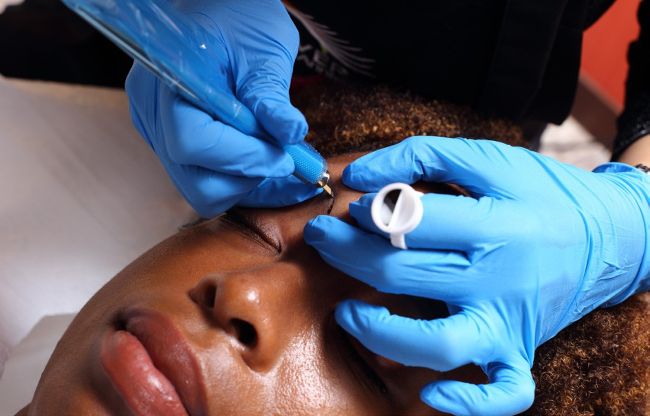Ask the Experts
Our experts answer questions around all aspects of the industry
What are the do’s and don’ts of semi-permanent eyebrow processes for skin of colour
Semi-permanent make-up has been helping people enhance their natural beauty for decades, but over the past few years, it has become easier for permanent make-up artists to specialise in melanated skin. For years, artists were told by their instructors that they could not perform permanent cosmetic services on skin of colour; technicians believed that permanent make-up healed poorly on darker skin. Fortunately, this myth has been dispelled and artists around the world are showing off beautiful healed results on skin of colour. However, if you wish to perform eyebrow processes on clients with deeper skin tones, there are a few things that you should keep in mind to ensure optimal healing.

Images from Shutterstock
Melanated skin tends to produce greater amounts of sebum and oils, which can encourage pigment migration. To counteract the risk, artists should be careful not to oversaturate the skin with pigment. When too much pigment is deposited, the skin is overworked and the brows may have an ashy or cool tone when healed. Regardless of skin tone, overworked skin may also become scarred or hyperpigmented. However, skin of colour can have a more severe inflammatory reaction to trauma, known as postinflammatory pigmentation, which results in skin discolouration. To minimise any risks to clients, you should be particularly attentive when working with skin of colour. You should not jump around or work randomly – filling one section at a time ensures that the skin is evenly saturated and the design is preserved.
Visual cues
You should also pay attention to the visual cues for skin of colour. When working with lighter skin tones, artists are able to pay attention to visual cues such as redness and bruising (a sign of trauma). However, visual cues can look different when working with skin of colour, making it easy for uninformed artists to accidentally overwork the skin. When working with melanated skin, keep an eye out for blood, swelling and excessive lymph. If you see any of these cues, you must give your client’s skin a break, switch to a slower speed, adjust the needle so that it does not snag, and ensure that you are applying gentle pressure. When working with melanated skin, you should be patient and take your time: a slower pace allows the pigment to oxidise, making it easier to see the level of saturation.
Hair stroke
When performing hair stroke techniques, it is best to keep ample space between each stroke until healed. At that point, you can see which lines should be added during a follow-up appointment in order to complete the design. The best eyebrow techniques for skin of colour are machine stroke and powder eyebrows. If done correctly, these techniques cause less trauma and allow the artist to increase definition via shading techniques. Microblading is not recommended on melanin-rich skin since it is more likely to scar, discolour, or result in keloids.
Pigments
When working on skin of colour, you can choose from a wide variety of pigment choices to achieve a beautiful, healed eyebrow – black pigments and orange modifiers are not the only options for permanent make-up on melaninrich clients. In fact, all-black pigment can lead to poor results when healed.
In order to understand the science behind different colours of pigment and how they affect healed results, artists must be knowledgeable in colour theory. Once you’ve mastered colour theory, you’ll be able to achieve browns that retain their warmth even when healed.
In summary to achieve beautiful healed results on skin of colour, you should:
• Work on a low speed
• Apply gentle pressure
• Avoid oversaturation
• Use a short needle that catches the skin
• Allow pigment to oxidize so you can see your work
• Work section-by-section
• Understand colour theory and the science of melanin
Dior Davenport is a co-founder of the Black Micropigmentation Association, a global non-profit organisation that is committed to supporting black artists in the permanent make-up industry and providing education, training and community for all. www.blackmicropigmentationassociation.com
DO YOU HAVE ANY QUESTIONS TO PUT TO OUR EXPERTS?
Send your questions about absolutely anything to do with running a beauty business to
joanna@ professionalbeauty.org.za